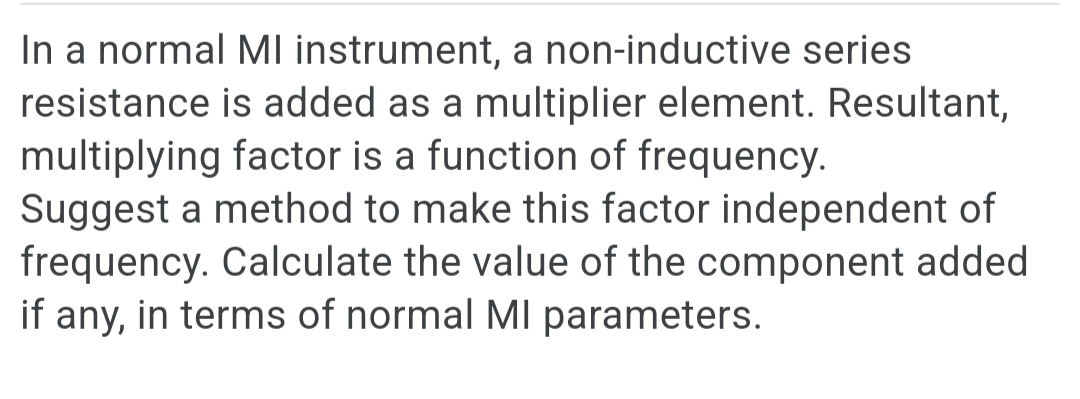In a normal MI instrument, a non-inductive series resistance is added as a multiplier element. The resultant multiplying factor is a function of frequency. Suggest a method to make... In a normal MI instrument, a non-inductive series resistance is added as a multiplier element. The resultant multiplying factor is a function of frequency. Suggest a method to make this factor independent of frequency. Calculate the value of the component added, if any, in terms of normal MI parameters.

Understand the Problem
The question is asking for a method to make the multiplying factor of a non-inductive series resistance independent of frequency in a normal MI instrument. Additionally, it requests a calculation of the value of the component added, expressed in terms of normal MI parameters.
Answer
Add a capacitor in parallel to the non-inductive series resistance, with a value determined by the desired multiplying factor $K$.
Answer for screen readers
A capacitor can be added in parallel to the non-inductive series resistance to make the multiplying factor independent of frequency. The required value of the capacitor can be calculated based on the desired multiplying factor $K$.
Steps to Solve
- Understanding the Requirement
The objective is to design a non-inductive series resistance that does not vary with frequency in a normal measuring instrument (MI). The multiplying factor is defined as the ratio of the output voltage to the input current.
- Analyzing the Frequency Dependency
In a normal MI instrument, the multiplying factor is affected by the reactance of circuit elements. The reactance, $X$, is frequency dependent, given by:
$$ X = 2 \pi f L $$
where $f$ is the frequency and $L$ is the inductance.
- Using a Suitable Configuration
To make the multiplying factor independent of frequency, we can employ a design that includes a feedback mechanism or use an additional component like a capacitor wired in parallel or a specific configuration of resistors.
- Calculating the Value of the Component Added
If a capacitor ($C$) is added, the total impedance ($Z$) of the circuit becomes:
$$ Z = R + \frac{1}{j \omega C} $$
where $\omega = 2 \pi f$ is the angular frequency. The multiplying factor, now dependent on $C$, can be set to a specific value independent of frequency.
To find the required value of $C$, we can rearrange and set the angular frequency term to cancel out any frequency dependency.
- Final Equation Set-Up
The ideal value of $C$ can be determined based on the desired frequency response. If the desired multiplying factor is $K$, it can be represented as:
$$ K = \frac{R}{\sqrt{R^2 + \left(\frac{1}{\omega C}\right)^2}} $$
- Conclusion
In summary, by introducing a capacitor in parallel, the effect of frequency can be minimized, making the multiplying factor independent of frequency.
A capacitor can be added in parallel to the non-inductive series resistance to make the multiplying factor independent of frequency. The required value of the capacitor can be calculated based on the desired multiplying factor $K$.
More Information
The method to achieve a frequency-independent multiplying factor is significant in ensuring accuracy in measurements across varying frequencies in MI instruments. The appropriate selection of components can greatly enhance performance.
Tips
- Assuming the scheme will remain effective without proper tuning of parameters.
- Neglecting to analyze how changes in component values affect the overall multiplying factor.
- Miscalculating the value of the capacitor based on incorrect assumptions about the resistor's behavior with frequency.
AI-generated content may contain errors. Please verify critical information